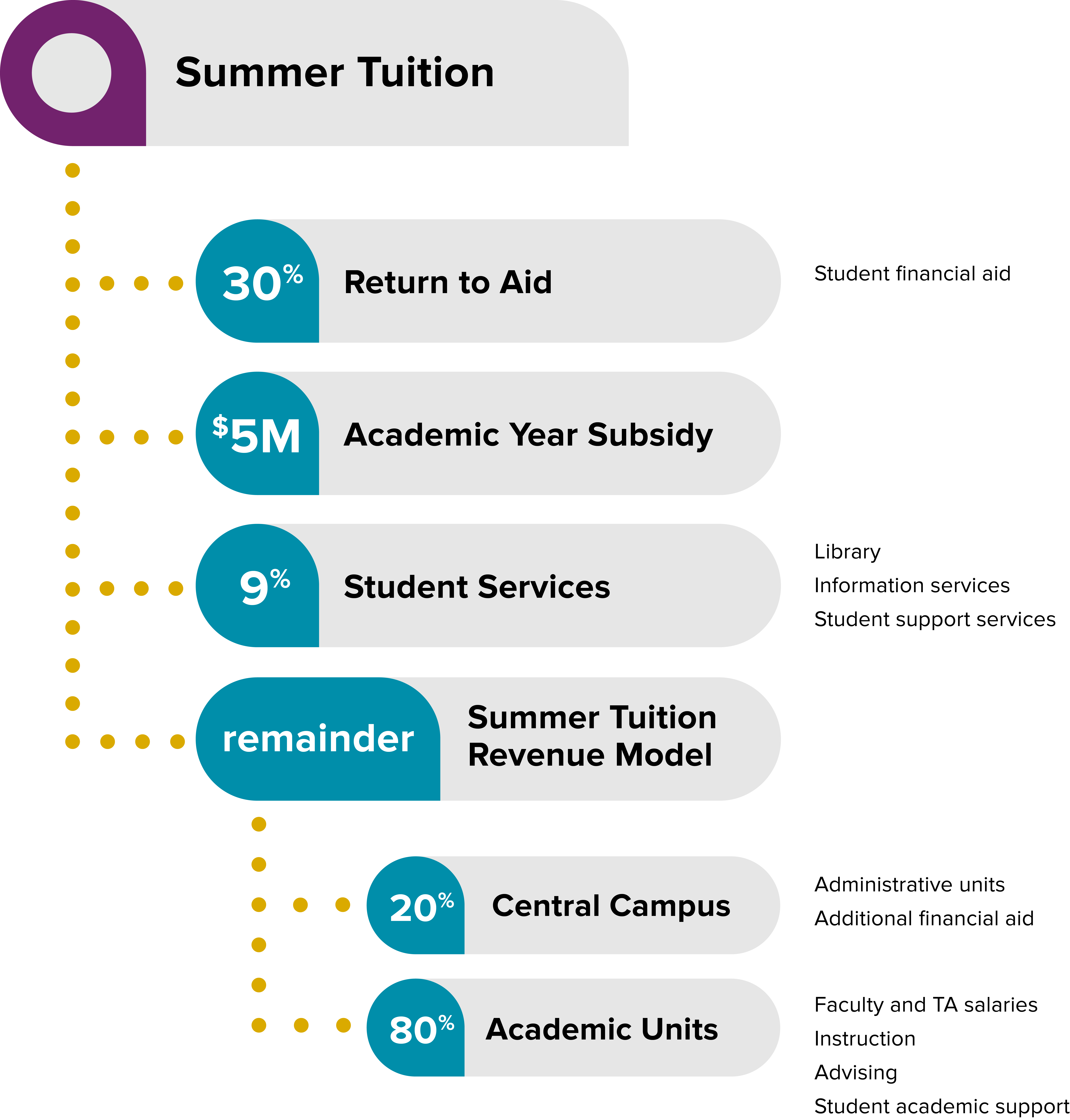Resources on the Incentive-Based Budget Model for Summer Session Tuition
Summer instruction is valuable for several reasons: it allows students to maintain or accelerate their time to degree, provides opportunities for students who would otherwise start in the fall to take courses before the beginning of the academic year, allows opportunities for innovative instructional formats, makes use of space, and generates additional funds. Historically, summer has been treated as a self-supporting program. Fees are expected to cover the full costs of instruction and associated indirect costs (such as library access and student services). Summer revenue has also been used toward academic year instruction and to mitigate impacts of state funding reductions.
Summer is different from the academic year in two important ways. First, students have less availability of financial aid programs, though in some years Pell Grant funding has been made available in the summer and the campus typically provides supplemental funding to meet students’ summer sessions aid need. Additionally, instructors, including some faculty, are hired for summer independent of academic year appointments and receive additional compensation tied specifically to summer teaching.
Like aspects of the Undergraduate Tuition Revenue model, the Summer Session Tuition Revenue (SSTR) budget model seeks to align resource allocation with teaching effort. In the case of the Summer budget model, the only metric used to determine allocations to units are Student Credit Hours (SCH) based on pay department. Students of all levels take, and pay tuition for, summer courses, so graduate and professional SCH are included in the Summer model.
After directing about 30% of summer tuition to return to aid, about $5 million maintains the historical subsidy to academic year funding that evolved out of changes to State support, and about 9% of revenue net of aid is directed to Student Affairs for services provided to students during the summer, the same proportion of funds they receive in the academic year if the Student Service Fee and tuition were combined. The remainder is split, 80% to academic units and 20% to the central campus. Units and the central campus use these funds similarly to UGTR funds during the academic year.
Allocations are typically made as permanent base budget increments to provide funding commensurate with workload. Due to the unprecedented growth of summer enrollment during Summer 2020 and Summer 2021, allocations were made on a one-time basis as it was unclear whether that enrollment level could be sustained. For Summer 2023-24, this pool was allocated as shown in Table 1 below:
Table 1. 2023-24 SSTR Allocations
| Unit | 2020-21 base budget | 2023-24 Increment | 2023-24 budget |
| Academic Units | $9.2M | -$302K | $8.7M |
| College of Agriculture and Environmental Sciences | $936K | -$87K | $852K |
| College of Biological Sciences | $895K | -$24K | $874K |
| College of Engineering | $576K | -$73K | $505K |
| College of Letters and Science | $6.5M | -$28K | $6.4M |
| Professional Schools | $339K | -$90K | $218K |
| Central Campus | $2.3M | -$135K | $2.2M |
| Total | $11.5M | -$437K | $11.1M |
Note: totals may not tie due to rounding
Resources (PDFs):
- SEM to DEANS re Final 2024-25 SSTR allocations.pdf - December 2024
- Summer Tuition Allocation - January 2024
- Summer Tuition Allocations - November 2022
- Archive: Summer Tuition Papers
- Issue Papers (PDFs):
Summer Sessions Program, Final – March 2014
Summer Tuition in the Budget Model Letter – January 2014
Prior Versions:
Summer Sessions Program, Version 1 – October 2013
Implementation (PDFs):
Summer Sessions: PPS Entry Guidelines, Version 3 – June 2014
Summer Sessions: Processes and Timeline – March 2014
Summer Sessions: Instructional Hiring - Decisions, Policies, Practices and Processes – March 2014
Summer Sessions: BIA Implementation Plans - Guidance – March 2014
Updates and Status Reports (PDFs):
Report on Summer Sessions Discussions, Version 1 – June 2015
Report on Summer Sessions Discussions, Executive Summary – June 2015
